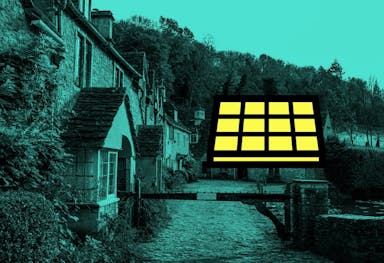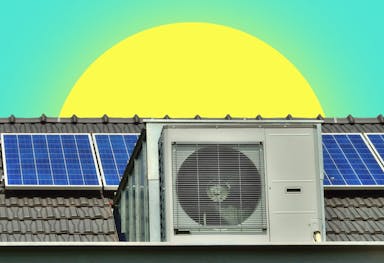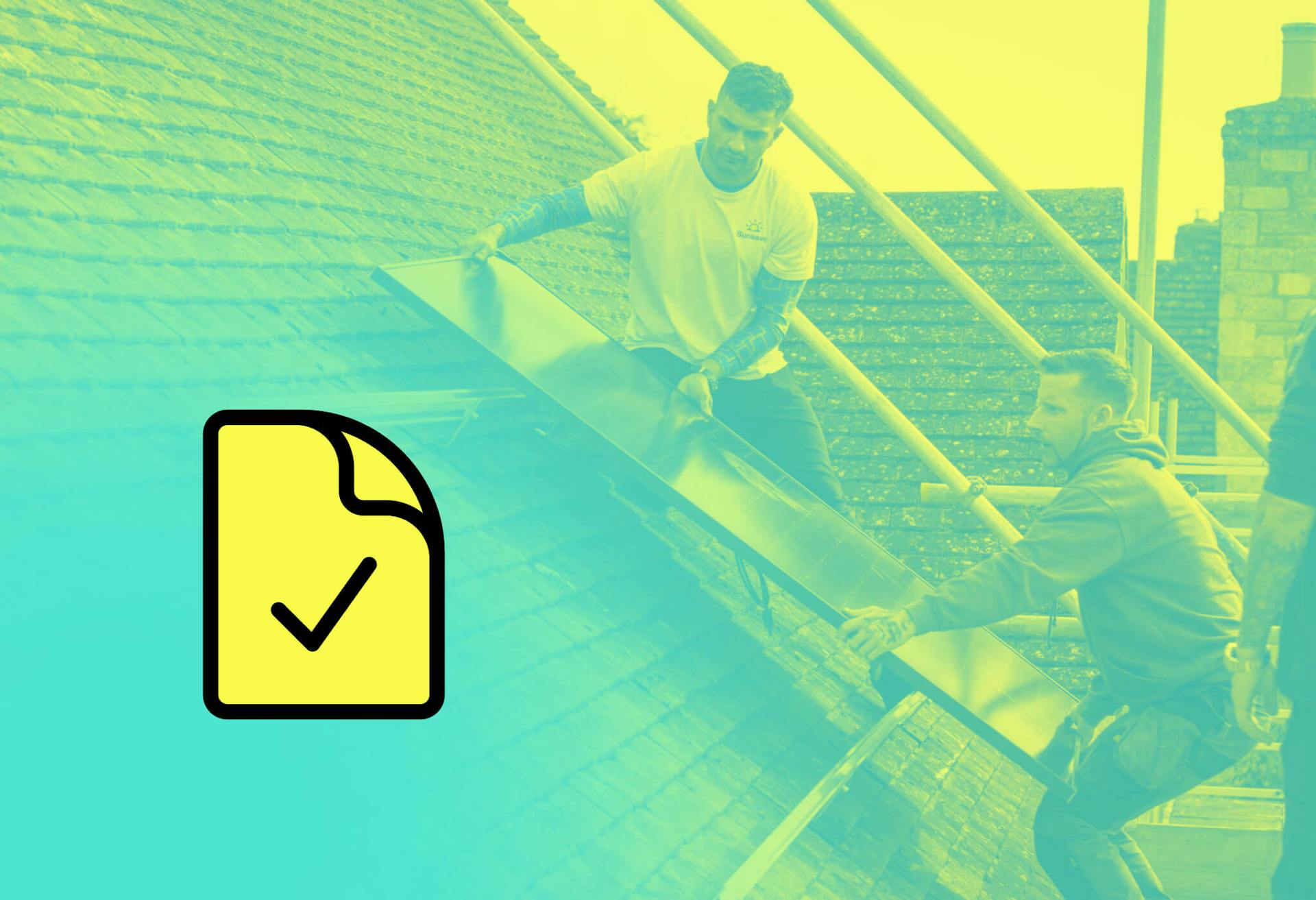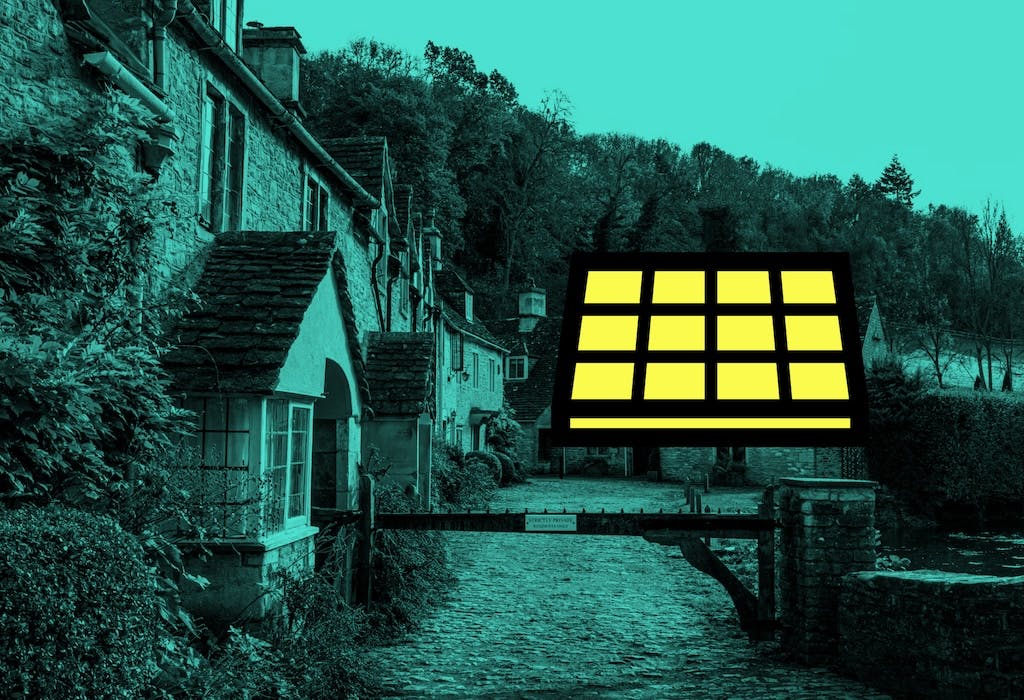- Solar advice hub
- Planning-permission
- Solar panels on listed buildings: explained
Solar panels on listed buildings: explained
Find out what solar panel restrictions are in place for listed buildings, how you can make an application, and whether it's likely to get accepted.


Why you can trust our content
We know that the solar industry is full of misinformation, but we only use reliable sources, including:
- Our experienced solar experts, installers and system designers
- Our own database of solar & battery system designs
- Authoritative bodies like MCS and the UK government




Calculate savings
What kind of home do you live in?
Calculate savings
What kind of home do you live in?
At a glance
The phrase 'listed building' will make most people think of stately homes and castles, but it actually covers a wide range of structures, including garden walls, mills, shops, bridges, factories, banks, and more.
And for a building to be listed, it doesn't need to be centuries old; the minimum age for a building to be considered by Historic England is just 30 years.
Once a building is listed, its architectural and/or cultural heritage is protected, which makes it more difficult to make any physical alterations the structure.
But as the UK moves towards Net Zero, owners of listed buildings face the slightly complicated challenge of reducing their carbon footprint whilst preserving their property's historical value. In this article, we'll tell you why it's complicated, but how the switch to solar can still be achieved.
And if you’d like to find out how much a solar & battery system could save you, answer a few quick questions below and we’ll calculate an estimate.
Find out how much you can save
What kind of home do you live in?
Can you put solar panels on a listed building?
You're allowed to install solar panels on a listed building, but you need listed building consent. If a building is listed, it has legal protection because of its historical or architectural significance - which means paying more attention to preserving its appearance.
Some listed buildings may not be suitable for a solar photovoltaic (PV) system if the installation would harm its significance, but many can accommodate it if fitted discreetly. Solar panels should be placed in less visible areas, so installing them on a prominent roof slope is usually not possible.
An unauthorised installation is a criminal offence and attempting to carry one out will land you on the wrong side of the law.
As of November 2024, there were around 370,000 listed buildings in England, which accounts for about 2% of the country's building stock.
And Historic England is very much in favour of putting solar panels on listed buildings, with a spokesperson telling Museums Journal in July 2024: "Mitigating climate change and conserving historic buildings are compatible goals".
What are the requirements for listed building consent?
To get listed building consent, you'll need to apply to your local planning authority and show them how the new solar panel system will affect the building's character.
The application needs to explain how the panels will be installed, how they will look, and how they will fit with the existing structure.
Once your application is submitted, your local authority will then assess the visual impact of your proposed solar installation, reviewing the colour, finish, and arrangement of the panels to make sure they will complement the building's aesthetics.
Requirements include:
- The building must be in a well-maintained condition before the installation of the solar panels
- The panels cannot cause any structural damage
- The panels shouldn't significantly change the building's appearance. As Historic England writes, "installation of panels will generally be acceptable if hidden from view" - although they also say that panels "on roof slopes of less prominence will generally be acceptable"
- The meter should be out of sight
- The installation must be reversible; none of the changes can be permanent
In November 2023, Historic England urged local authorities in to approve solar and heat pump installations on heritage buildings, unless they result in "unacceptable harm".
Before making your application, it's advisable to contact your local authority's conservation team, as they can give you advice on what's likely to be accepted.
Certain listed buildings may have unsuitable roofs with intricate or delicate roof tiles, making solar installations costlier or riskier. In those cases, ground-mounted solar panels in the gardens or grounds can be a viable alternative.
Grade I vs Grade II listed building requirements
In the world of listed buildings, all these protected properties are important, but some are a bit more important than others.
That's why Historic England has a grading system: Grade I, Grade II*, and Grade II.
A Grade I listed building is of exceptional interest, and includes properties like the Houses of Parliament and St. Paul's Cathedral.
A Grade II* listed building is of more than special interest, and includes properties like Battersea Power Station and Shibden Hall in Yorkshire.
And a Grade II listed building is only of special interest, and this includes properties like Abbey Road Studios and Alexandra Palace. It is also the most likely grade listing for a homeowner.
Only 2.5% of England's listed buildings are Grade I, 5.8% are Grade II*, and the other 91.7% are Grade II.
If you're lucky enough to live in a Grade I or Grade II* listed building, the requirements for solar panel installations are a little more stringent. Historic England does not provide further specifics, but simply says that listed buildings of the "highest significance" are "likely to be more sensitive to change and therefore may need different approaches".
The application process will be the same, but be aware that the room for leniency - and the possibility of minor alterations to the property's visible appearance - will be zero.
Listed church requirements
You can install solar panels on a listed church, but the process involves specific permissions from the church's relevant denominational authority rather than listed building consent (plus, you'll still need to apply for planning permission).
This mainly applies to churches eligible for ecclesiastical exemption, such as those in the Church of England, Roman Catholic Church, Baptist Union, Methodist Church, and United Reformed Church.

How to apply for listed building consent
To apply for listed building consent, you need to submit an application to your local planning authority. You (or your installer) can do this online through the Planning Portal or by downloading the relevant forms from your local authority's website.
Your application must include:
- detailed plans and drawings to show the proposed changes and their impact on the building's character
- a heritage statement (also known as a statement of heritage significance)
- a heritage impact assessment to justify why the changes are necessary and desirable
- a design and access statement.
It's usually free to apply for listed building consent, but there may be other fees if the application is part of a group of other planning permission applications for the same works - for example, if you’re building an extension.
How long does it take to get listed building consent?
It usually takes around eight weeks to get listed building consent, but it can take longer in more complicated situations.
Sometimes you might need further consultations with local conservation officers, and revisions to the application to ensure that the building's character is being adequately preserved.
And if the application involves a Grade I or Grade II* listed building or includes significant alterations like demolition, the process may call for specialist advice.
Find out how much you can save
What kind of home do you live in?
Ground-mounted solar panels for listed buildings
When rooftop solar PV installations would significantly affect a listed building's appearance, ground-mounted systems can be a good alternative.
As Historic England writes in its Advice Note 18 from July 2024, "mounting panels on outbuildings or land associated with a listed building, provided they are not of greater prominence, will generally be preferable to installation on the main building".
As with a rooftop solar array, careful planning and consultation with local conservation officers is essential.
To learn more, check out our full guide to ground-mounted solar panels.
Solar roof tiles for listed buildings
Despite the sleek appearance of modern solar panels, there are still people out there who find them to be an eyesore. This is why solar roof tiles (or 'solar slates') were invented - to imitate the appearance of traditional roof tiles, and make the switch to solar more appealing to people with an aesthetic gripe.
In the case of listed buildings, people might assume that solar roof tiles are perfect, because they blend in better than traditional panels.
However, Historic England is pretty clear on the matter: "As [solar slates] do not usually convincingly replicate the look of traditional slates, they would not be suitable for prominent roof slopes where panels would also be unacceptable".
No room for misinterpretation there.
But in the case of listed buildings where traditional solar panels would be feasible, solar roof tiles are also a valid option. Historic England states: "Solar slates replace existing roof coverings and are an alternative solution to photovoltaic and solar panels".
The only important thing is that you think about the long term. As Historic England points out, solar roof tiles have a considerably shorter lifespan than traditional panels, and they're more difficult to maintain and replace.
To learn more, check out our full guide to solar roof tiles.
Famous listed buildings with solar panels
Despite hailing from the past, many listed buildings in the UK are very forward-looking - and some of them are now bedecked with shiny solar panels.
Allow us to run through some of our favourite green-minded heritage properties, some of which made their prescient switch to solar in the black-and-white days of 2012.
Chester Cathedral
In February 2023, Chester Cathedral became the first cathedral in the north of England to install solar panels "on its ancient monastic building".
The Grade I listed cathedral now has 206 solar panels on several of its South Transept and Nave roofs, and these panels produce around 22-25% of the building's total energy consumption.
These panels use a clever design which enables them to sit on the cathedral roof, rather than being fixed to it.
Sutton Hoo visitor centre, Suffolk
The new visitor centre at Sutton Hoo, a prehistoric heritage site, had 172 high-efficiency solar panels installed by the National Trust in March 2024.
These panels generate around 42,000 kilowatt-hours (kWh) of electricity every year - enough to power over 10 three-bedroom homes.
King's College Chapel, Cambridge
Cambridge University's Grade-I listed King's College Chapel had 497 solar panels installed on its roof in November 2023, as part of extensive renovation work.
The panels are set to generate 123,000kWh of electricity each year, covering all of the Chapel's electricity needs.

King's Cross train station, London
King's Cross train station, a Grade-I listed building, uses 1,392 custom-made glass laminate solar panels. These were installed in October 2012, and have been integrated across 2,300 square metres of the station's glass roof.
These panels generate 175,000kWh of electricity each year, resulting in an annual reduction of over 100 tonnes of CO₂ emissions.
Chippenham Hall, Cambridgeshire
Grade-II listed Chippenham Hall had 32 ground-mounted solar panels installed in October 2023, hidden from view for members of the public by a hedged enclosure.
The enclosure blends well with the rest of the property's pleasure grounds, which date from 1702.
Gloucester Cathedral
Grade-I listed Gloucester Cathedral had 150 solar panels installed on its roof in September 2016, which provide roughly 25% of its electricity needs.
The panels are hidden from view to people on ground level because of the roof's slant and tall parapet.
Next steps
The UK is lucky to have so many buildings of historic significance on its shores, and their aesthetic preservation is hugely important.
However, this doesn't mean that these buildings should be left behind by the UK's green transition - especially not homeowners with beautiful properties but sky-high energy bills.
Historic England does vital work establishing standards for solar panel installations on listed buildings, otherwise it could be history-smashing chaos.
Providing you collaborate with local conservation officers to design a suitable system, your switch to solar shouldn't be a problem.
To find out how much a solar & battery system could save you, provide a few quick details below and we'll generate an estimate.
Find out how much you can save
What kind of home do you live in?
Solar panels on listed buildings: FAQs
Related articles

Written byCharlie Clissitt
Born in Yorkshire and now living in London, Charlie has been in the renewable energy industry since 2017, having worked as a writer and then editor of green technology advisor The Eco Experts. His work has focussed on educating UK homeowners about a wide range of residential power and heating solutions, including solar panels, storage batteries, heat pumps, infrared panels, and EV chargers.









